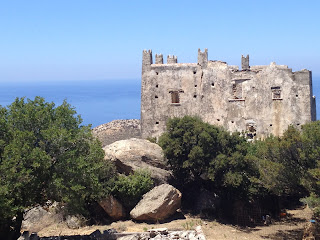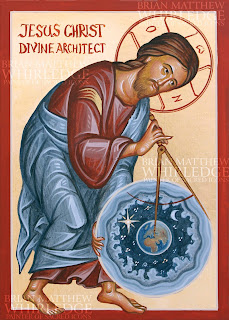Naxos Island
Yesterday we explored the island in an authentic fashion:
moped. We rented our bike from the newly
opened “Motopower” store where we walked in on the blessing by the village
priest. We shelled out €12 to rent the
bike for the day, drove the nearest gas station to fill it up, and we were on
our way.



We drove past the cathedral of the Metropolis of Paros and
Naxos. We stopped in to find a beautiful
church with many frescoes, and a large icon, with a reliquary, of St. Nikodemos
of the Holy Mountain, who was a native of Naxos. St. Nikodemos was a leader in the Kollyvades
movement in the 19th century that prompted a revival in popular
piety and a return to traditional practices.
He edited and published many patristic works, including the Philokalia,
a patristic book on the prayer of the heart.


On the way back down the causeway, Bekah’s favorite sandals
broke.

Within the outer walls is the village cemetery.


First stop was Chora, also called Naxos Town.


We continued through Naxos town to an ancient monument
called the Portara or the Apollo Temple that looks like it came from a
science fiction film. The thing is huge…
impressive how a lintel that large could be lifted into place. This is part of
a temple, and is on its own small island connected to the town by a narrow
causeway.


Fortunately, there was a souvenir shop nearby offering flip
flops among everything else.
We were on our way.
The plan was to travel around coast of the island to the north-eastern
town of Apollon, then head inland through several small towns, and back to Agia
Anna.
The first stop was a little shrine by the side of the road
just outside Naxos Town. As we soon
discovered, these delightful little shrines are frequently found along the
roads throughout Naxos.
We went into the town of Galini, where the map said was an
old monastery. We didn’t find the
monastery, but we did find an exceedingly angry old man who passionately told
us (in Greek) to get out of town how to get to the beach.
The road was very winding and mountainous, often dropping
off vertically to the sea.
There were countless churches and chapels dotting the
landscape. There had to have been at
least one every mile. This is so impressive and the faith of the people of
Naxos is inspiring. When Bekah and I
build our dream house, there will be a chapel on the property.
We passed an old castle tower from the period when Venetians
ruled Naxos.
Just before Apollon we came upon an enormous, unfinished
statue in an ancient marble quarry.
Apollon is a beautiful little port where we ate lunch by the
beach.
Bekah enjoyed zucchini balls with tzasiki sauce and wine, while I indulged in fried eggplant with tsakiki, a Greek salad, and wine. Our bill? €12.
We continued our moped adventure by climbing the mountains
to go inland. The vegetation was
flourishing in the mountains. Everything
was lush and green. The farmers on Naxos
take advantage of this fertility by planting everywhere… even if it means
carving terraces into the mountains.Bekah enjoyed zucchini balls with tzasiki sauce and wine, while I indulged in fried eggplant with tsakiki, a Greek salad, and wine. Our bill? €12.
Naxos is the most self-sufficient island in the
Cyclades. The high mountains catch
clouds and produce more rain than the other islands, especially Santorini and
Anafi to the south, which are climatologically deserts.
We passed several small villages grasping the sides of the
mountains.
And countless chapels.
The roads were more winding, steep, and, well, scary, than
along the coast.
At the highest point in our journey, we came across dozens
of windmills generating power to the island.
The people of Naxos have evidently used wind power for ages.
On the way down, and after passing several tiny villages, we
passed through the village of Moni, named for an ancient monastery that has
long disappeared. All that remains is
the remarkable Panagia Drossiani church.
For me, this ancient church was the highlight of Naxos.
The nave was built in the 4th century… just after
Christianity was granted legal tolerance and before the canon of the New
Testament was assembled. It was amazing
to pray in a church that is older than the Bible itself.
The ancient icons are barely perceptible.
Several side chapels have been haphazardly tacked on through the
centuries.
The church is home to the wonderworking icon of the Virgin
Mary, called Panagia Drossiani. Panagia, meaning “All-holy one” is an
affectionate Greek term for the Virgin Mary.
“Drossiani” means “dewy” and comes from the fact that for centuries,
this icon has wept myrrh every time the village of Moni has been in danger.
Within the outer walls is the village cemetery.
We descended from the mountains, past a pottery. The potter was closing up his shop as we
arrived and told us to hurry up. He
spoke little to no English. We bought a
beautiful carafe and six cups for €18.
We continued into a fertile valley with many crops and
pastures.
We followed a narrow road that seemed to go nowhere. Eventually, we came across an ancient pagan
temple. This temple was evidently an
important step in the development of Greek architecture. Like most pagan temples, an apse was added
and it was converted to a Christian church in the 4th or 5th
centuries. The ages have not been kind,
but it is one of the better preserved temples.
We stopped in the small town of Tripodes to get directions
(entirely in Greek) back to Agia Anna. It
was simple, as the man told us, and we soon found ourselves relaxing in the
water at the beach.
We indulged in salatouri (a salad made with locally caught ray,
as in sting ray, onions, parsley, and olive oil), eggplant saganaki (a repeat
from the other day, since it was too good… local eggplants fried in a sauce of
tomato, feta, and ouzo), fried tope (also locally caught and the best fried
fish we’ve ever had) with a garlic spread (to quote Nicholas, our waiter, it
was a “taste explosion”). We finished
dinner with a spread of many local aged cheeses with a local Rose wine.
Ioanna, our hostess from the hotel, told us she would pick
us up between 8:30 and 8:45 to take us to the port for our 9:30 ferry. She finally arrived at 8:56, and took us the
back way into town on a narrow, bumpy, one-lane, dirt road between fields, and
lined with trees. Maybe on a good day,
it would have been a shortcut, but of course we were stuck behind a load of
potatoes.
We arrived at the port just in time for the ferry. I gave Ioanna €60 for our three nights in the
hotel. I’m not entirely sure she
would’ve even brought it up if I hadn’t.
I am impressed by the trusting and carefree people of the island. On the drive to the hotel from the port on
the first day, I asked Ioanna how much we owed.
“Don’t worry about it until you leave.” The lady at the market didn’t
have 40 cents in change, so she told us to take the water bottle and pay in the
morning. When we asked for carryout at O
Patatosporos, Nicholas said he didn’t have boxes, but he could wrap the plate
in aluminum foil and we could just bring the plate back the next day. This is certainly a different pace than the
hustle and bustle of Athens.




























Comments
Post a Comment